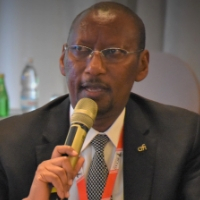8 March 2019
How Rwanda narrowed its gender gap in financial inclusion, Governor John Rwangombwa talks about the importance of women’s economic empowerment
Rwanda is a success story for gender equality policies and women’s equal participation in all spheres of life. In conjunction with 2019 International Women’s Day, AFI had the opportunity to talk to the Governor of the National Bank of Rwanda, John Rwangombwa about the importance of women’s economic empowerment and how Rwanda narrowed its financial inclusion gender gap.

Governor John Rwangombwa, National Bank of Rwanda
AFI: Despite consistent efforts, the financial inclusion gender gap in developing and emerging economies has remained at 9 percent since 2011. How do you explain this and why do you think this is the case?
Governor of the National Bank of Rwanda, John Rwangombwa: One reason behind this is general gender inequality practices across many countries. It is not just an issue of financial inequality. When you look at the causes of financial exclusion, lack of education is one of the biggest issues. We have seen challenges in girls’ education in many of these countries. They are disadvantaged in that their brothers and men take advantage of opportunities that arise because they are well, or better, positioned in society.
The other is culture. In some countries, women remain the subjects of men and do not have the right to own property. Many challenges are causing gender inequality that, in turn, feed the financial inclusion gender gap. Linked to this is income. Many women remain at home, raising their families and do not generate an income, which is a challenge and one of the reasons behind why we do not see the financial inclusion gender gap reducing. While women are being financially included, men often take advantage of women because of these socio-cultural challenges.
AFI: The financial inclusion gender gap in Rwanda has narrowed from 14 percent in 2014 to 11 percent in 2017 according to the Global Findex Database. How do you think technology helped narrow this gap in Rwanda?
Governor John Rwangombwa: In Rwanda, we have made concerted efforts to enable women to be part of the development agenda, with initiatives across the country to mobilize and include them into associations and cooperatives, which then assist them to participate in savings groups.
Generally, the biggest challenge facing financial inclusion is access. This access barrier was broken when technology came onboard. Financial services were brought closer to populations through their phones. With efforts to mobilize women to start income generating projects, they are also able to take advantage of technological developments such as mobile-phone based financial services.
We, as a central bank, have worked towards providing sex-disaggregated data that shows real financial inclusion and so we are able to make decisions based on concrete numbers. We know where the problems are, have mapped them across the country and, therefore, have targeted efforts in place to address these issues. There are a lot of efforts going on to empower women economically. As technology comes on board, it complements these efforts and makes it easier to bring more women on board.
AFI: How important is women’s financial inclusion in driving women’s economic empowerment globally?
Governor John Rwangombwa: Financial inclusion is an answer to inclusive growth. With access to financial services, we can save, invest and mitigate risks. Women make up a large proportion of the populations of different countries, so by bringing them on board you are empowering them and making them economically included. Also, women are better managers of resources than men, so they are better managers of risks.
If you really want to empower nations and communities, you must empower the women of those communities.
National Bank of Rwanda (BNR), together with AFI, is co-hosting 2019 AFI Global Policy Forum. BNR will showcase the country’s financial inclusion experience, as well as highlight how the use of technology can bring progress in financial inclusion of the most vulnerable groups, especially women and youth.
© Alliance for Financial Inclusion 2009-2025